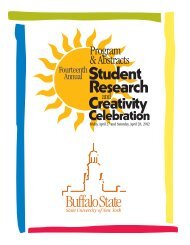POLITICS VERSUS SCIENCE: APPORTIONING ... - Buffalo State
POLITICS VERSUS SCIENCE: APPORTIONING ... - Buffalo State
POLITICS VERSUS SCIENCE: APPORTIONING ... - Buffalo State
Create successful ePaper yourself
Turn your PDF publications into a flip-book with our unique Google optimized e-Paper software.
Mouth Disease (FMD) is illustrative of this point. The polity clamored for vaccination of<br />
cattle, but scientists warned that vaccination does not guarantee against the spread of<br />
FMD. It is only by having unvaccinated herds that scientists can easily detect the<br />
presence of the organism. Given the low risk of FMD, scientists select not to vaccinate.<br />
There are three issues upon which science and politics regularly disagree: 1) risk<br />
assessment, 2) risk management, and 3) the interconnectedness of risk assessment, risk<br />
communication, and risk management. Risk assessment is sometimes mistakenly thought<br />
to be an uncontroversial exercise of science. Nevertheless, any decision based on<br />
differential risk thresholds will affect those for whom the standards are designed to<br />
protect. Assumptions may be risk-averse, risk-tolerant, and risk-neutral. Scientists, for<br />
instance, might employ a mathematical model (quantitative estimates) or safety factor<br />
(qualitative). Harrison and Hoberg (1994, 27) explain that “mathematical models derive<br />
quantitative estimates of the likelihood of risk experienced by different members of the<br />
population corresponding to the extent of their exposure.” Safety factor is a qualitative<br />
risk assessment in which “those whose exposure is less than the assumed threshold are<br />
considered to face no risk of cancer.” They found, for example, that in the risk<br />
assessment of TCDD (the most toxic dioxin) professionals in the U.S. were more likely to<br />
employ mathematical modeling, while scientists in Canada supported the safety factor<br />
approach. Jasanoff (1990, 61) recounts the observation of a Dow Chemical executive<br />
that “if one wishes to eat fish caught in the Great Lakes, one had better do it in Canada.<br />
The fish is safe across the border, even though the dioxin residues have led U.S.<br />
regulators to label it unfit for human consumption.” Harrison and Holberg (1994, 117)<br />
conclude that the different approaches to risk assessment in the two countries can be<br />
5












